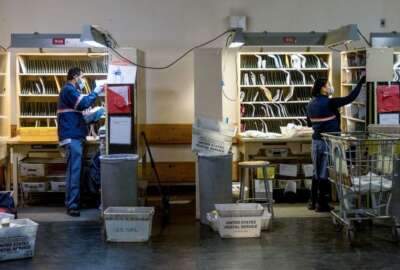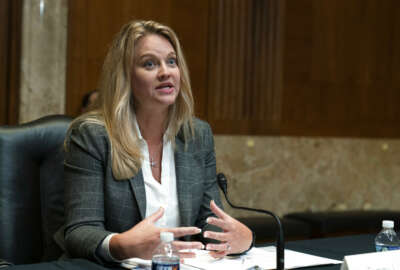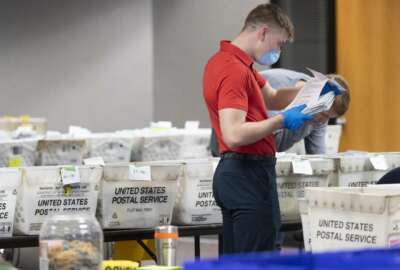Biden’s picks on USPS board push back on ‘dangerous risks’ in plan to slow down mail
Two of President Joe Biden’s picks to serve on the USPS Board of Governors pushed back strongly on USPS plans to slow first-class mail and about a third...
The Postal Service’s inspector general, its regulator and members of Congress are sounding alarms over the agency’s plans to increase mail prices and slow the delivery of nearly 40% of first-class mail.
But the most recent, and significant, round of criticism is coming from within USPS itself.
Two of President Joe Biden’s picks to serve on the USPS Board of Governors, in the first public meeting of their tenures, pushed back strongly on USPS plans to slow first-class mail and about a third of first-class packages — small, lightweight parcels that include prescription drugs and small electronics.
Postmaster General Louis DeJoy, speaking at Friday’s meeting, acknowledged that the 10-year reform plan, which includes these slower service standards, introduces some “uncomfortable changes” and draws scrutiny from the public. But USPS, he said, can’t continue with the status quo, adding that “what we have done in the past has not worked.”
“The majority of the roar is to stop what we are doing. Study more, increase service, keep prices low, cut employee benefits and host other single-interest issues disguised as solutions, which they are not. The best days of this thinking, and what it has to offer, has come and gone, and has created a Postal Service that I joined 14 months ago, one whose existence as we know it is threatened,” DeJoy said.
But drawing on other recent criticism of the 10-year plan, former Deputy Postmaster General Ron Stroman, one of Biden’s three appointees to the board, said the plan to slow down delivery for first-class mail and packages was “strategically ill-conceived, creates dangerous risks that are not justified by the relatively low financial return, and doesn’t meet our responsibility as an essential part of America’s critical infrastructure.”
Stroman said the plan would disproportionately impact seniors, low-households and small businesses that are some of the agency’s most loyal customers. Meanwhile, he expressed concerns that the plan would have a significant regional impact on Florida, Texas, Maine, California and central regions of the country.
“There’s no compelling financial reason to make this change. The relatively minor savings associated with changing service standards even if achieved will have no significant impact on the Postal Service’s financial future,” Stroman said.
Other reviews of the 10-year plan are more nuanced. Former American Postal Workers Union General Counsel Anton Hajjar, another of Biden’s appointees to the board, said “there is a whole lot to like” in the 10-year plan, including converting more USPS employees to career status, and investments in a new fleet of delivery vehicles and equipment at processing plants.
“The current management attitude stands in stark contrast to what I experienced in my decades of interacting with postal management. The attitude then was to shrink the organization until doomsday arrived,” Hajjar said.
By contrast, Hajjar said he believes DeJoy is fully committed to the 10-year plan and “intends to seize every opportunity to grow the Postal Service’s business.”
However, Hajjar expressed concerns with public pushback on the proposed service changes, especially given the Postal Regulatory Commission’s strong reservations with the plan in its recent advisory opinion.
“It seems to me that the Postal Service proposal sort of squeaked through the regulatory process … I ask why this change needs to be implemented now. Why not wait until management implements the impressively innovative changes in the [Deliver for America] plan, and see what can be achieved?” Hajjar said.
Board Chairman Ron Bloom, in his opening remarks, acknowledged there would be dissent among board members over these management issues.
“While we do not and will not always agree on the important issues that the Postal Service faces, I know that each of us has the best interest of the Postal Service and the American people at heart,” Bloom said.
Amid these disagreements, the Postal Service intends to move forward with these proposed changes. In a final rule posted Friday afternoon, USPS announced its new service standard for first-class mail and periodicals will take effect Oct. 1.
USPS said it “largely agrees” with the recommendations the PRC issued in its non-binding advisory opinion, but disagreed with how the commission evaluated the agency’s evidence and claims during the proceedings.
The commission warned that the plan, as written, would not result in “much improvement, if any” to USPS’s current financial condition, and wouldn’t immediately result in the agency reaching its on-time delivery goals, calling its 95% on-time delivery target for mail “aspirational.”
USPS said it will set up “interim targets” for on-time delivery as it implements the plan.
“The Postal Service has not claimed that it will achieve the 95%service performance target set forth in the Delivering for America plan instantaneously with the service standard change; rather,
the implementation of this change is a necessary step towards ultimately achieving that
target, in conjunction with other elements in the plan,” the agency wrote.
USPS received more than 136,000 public comments over the proposed rule, though the agency notes many of the comments raised concerns outside the scope of the proposal, such as concerns over privatizing USPS, the removal of sorting machines and collection boxes, as well as “the tenure of the current Postmaster General.”
“While almost all commenters express some form of opposition to the changes, they do not
offer clear alternative proposals or revisions,” the agency wrote.
USPS spokesman Dave Partenheimer said a majority of first-class mail will adhere to current service standards, and that the agency will deliver 70% of first-class mail within one to three days.
“The service standard changes are part of our balanced and comprehensive Delivering for America Strategic Plan, and will improve service reliability and predictability for customers and enhance the efficiency of the Postal Service network,” Partenheimer said. “The service standard changes that we have determined to implement are a necessary step towards achieving our goal of consistently meeting 95% service performance.”
Despite these contentious issues, USPS still faces long-standing financial challenges. USPS ended the third quarter of FY 2021 with a $3 billion net loss, despite an $845 million increase in revenue. That’s worse than the $2.2 billion loss it reported for the same period last year.
USPS Chief Financial Officer Joe Corbett said shipping and package volume dropped more than 14% compared to last year’s third quarter, signaling that a pandemic surge for package deliveries is slowing. For some context, however, package volumes still remain higher than pre-pandemic levels.
“While we don’t expect package volume to go back to the level where it was before the pandemic began, we believe it will continue to be elevated into the future,” Corbett said.
USPS Chief Technology Officer Scott Bombaugh said the agency delivered 87.6% of first-class mail on time in the third quarter, compared to 90.2% on time for the same period last year. USPS delivered first-class mail in an average of 2.4 days this quarter, compared to 2.3 days for the same period last year.
Copyright © 2025 Federal News Network. All rights reserved. This website is not intended for users located within the European Economic Area.
Jory Heckman is a reporter at Federal News Network covering U.S. Postal Service, IRS, big data and technology issues.
Follow @jheckmanWFED






